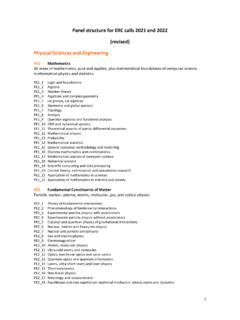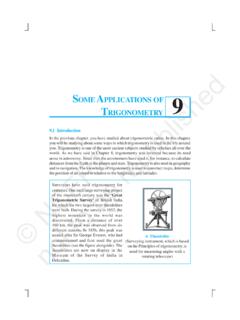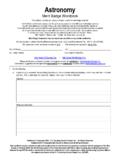Transcription of The Planetary and Lunar Ephemerides DE430 and DE431
1 1 IPN Progress Report 42-196 February 15, 2014 The Planetary and Lunar Ephemerides DE430 and DE431 William M. Folkner,* James G. Williams, Dale H. Boggs, Ryan S. Park,* and Petr Kuchynka** Mission Design and Navigation Section. Tracking Systems and Applications research described in this publication was carried out by the Jet Propulsion Laboratory, California Institute of Technology, under a contract with the National Aeronautics and Space Administration. 2014 California Institute of Technology. Government sponsorship The Planetary and Lunar Ephemerides DE430 and DE431 are generated by fitting numerically integrated orbits of the Moon and planets to observations. The present-day Lunar orbit is known to submeter accuracy through fitting Lunar laser ranging data with an updated Lunar gravity field from the Gravity Recovery and Interior Laboratory (GRAIL) mission. The orbits of the inner planets are known to subkilometer accuracy through fitting radio tracking measurements of spacecraft in orbit about them.
2 Very long baseline interfer-ometry measurements of spacecraft at Mars allow the orientation of the ephemeris to be tied to the International Celestial Reference Frame with an accuracy of 0 .0002. This orien-tation is the limiting error source for the orbits of the terrestrial planets, and corresponds to orbit uncertainties of a few hundred meters. The orbits of Jupiter and Saturn are determined to accuracies of tens of kilometers as a result of fitting spacecraft tracking data. The orbits of Uranus, Neptune, and Pluto are determined primarily from astrometric observations, for which measurement uncertainties due to the Earth s atmosphere, combined with star catalog uncertainties, limit position accuracies to several thousand kilometers. DE430 and DE431 differ in their integrated time span and Lunar dynamical modeling. The dynamical model for DE430 included a damping term between the Moon s liquid core and solid man-tle that gives the best fit to Lunar laser ranging data but that is not suitable for backward integration of more than a few centuries.
3 The ephemeris DE431 is similar to DE430 but was fit without the core/mantle damping term, so the Lunar orbit is less accurate than in DE430 for times near the current epoch, but is more suitable for times more than a few centuries in the past. DE431 is a longer integration (covering years 13,200 to +17,191) than DE430 (covering years 1550 to 2650).I. IntroductionThe Planetary and Lunar ephemeris DE430 succeeds the ephemeris DE421 [1] and its pre-cursor DE405 [2] as a general purpose ephemeris. Several interim Ephemerides have been released since DE421 with specific improvements in estimates of the orbits of Mercury, Mars, and Saturn intended primarily to support the Mercury Surface, Space Environment, 2 Geochemistry, and Ranging (MESSENGER), Mars Science Laboratory, and Cassini missions. These interim Ephemerides had small deficiencies in other areas, particularly the Lunar librations. DE430 has been updated for all bodies, including the positions and velocities of the Sun, Earth, Moon, and planets, along with the orienta-tion of the Moon, result from a numerically integrated dynamical model.
4 They are stored as Chebyshev polynomial coefficients fit in 32-day-long segments [3]. DE430 also includes Chebyshev polynomial coefficients fit to a numerically integrated difference between ephemeris coordinate time and terrestrial time. Parameters of the dynamical model have been adjusted to fit measurements of the relative positions of the planets and Moon with respect to Earth. The dynamical model is similar to that used for DE405 [4], but includes a model for the fluid core of the Moon [5,6] and an updated treatment of asteroids. The coordinate system and units are similar to those used for DE421 and DE405, but include changes to the definition of coordinate time and the astronomical from 343 asteroids have been included in the dynamical model. The asteroid orbits were iteratively integrated with the positions of the planets, the Sun, and the Moon. The set of 343 asteroids is identical to the set used in DE421. The set represents 90 percent of the total mass of the main belt and contains the asteroids with the most significant ef-fects on the orbit of Mars in terms of perturbation amplitude and frequency [7].
5 For DE421, a limited number of individual asteroid mass parameters were estimated, with the rest of the asteroid mass parameters determined by dividing them into three taxonomic classes, estimating a constant density for each class, and using volumes estimated from Infrared Astronomical Satellite (IRAS) observations [8]. For DE430 , we estimated the mass parameter for each asteroid individually subject to a priori values and uncertainties for volume and density derived from the Wide-field Infrared Survey Explorer (WISE) and the Supplemental IRAS Minor planet Survey (SIMPS) [9,10].The Lunar dynamical model for DE430 includes interaction between the rotation of the fluid core and the mantle. The effect of this interaction is clearly seen in Lunar laser ranging (LLR) data and characterizes a damping in the differential rotation between the core and mantle. Because the initial conditions of the Lunar core cannot be determined perfectly, er-ror grows in backward integrations when this interaction model is included.
6 Consequently, the DE430 time span has been limited to the years 1550 to 2650. Further information on the Lunar coordinate system and data reduction is available order to provide a general ephemeris covering several thousand years, a Lunar model without the core mantle interaction term has been used for the ephemeris DE431 . DE430 and DE431 have been fit to the same data. The difference in the orbits of the planets be-tween DE430 and DE431 is less than 1 m over the DE430 time span, which is well below the estimated uncertainties from the fit. The difference in the orbit of the Moon between DE430 and DE431 is less than 1 m during the time span of the LLR data, 1970 to 2012, but grows over longer times primarily due to a difference in estimated tidal acceleration. Fig-ure 1 shows a plot of the difference between the Lunar orbit in DE430 and J. G. Williams, D. H. Boggs, and W. M. Folkner, DE430 Lunar Orbit, Physical Librations and Surface Coordinates, JPL Interoffice Memorandum 335-JW,DB,WF-20130722-016 (internal document), Jet Propulsion Laboratory, Pasadena, Cali-fornia, July 22, 2013.
7 3DE430 should be used to analyze modern data. DE431 is suitable for the analysis of earlier historical observations of the Sun, Moon, and planets. The DE431 time span from the year 13,200 to the year 17,191 extends far beyond historical times and caveats are offered. For the planets, uncertainties in the initial conditions of the orbits will cause errors in the along-track directions that increase at least linearly with time away from the present. Resonances including, but not limited to, those between Jupiter and Saturn, and between Uranus, Neptune, and Pluto, may complicate the propagation of errors. Typically, the along-track component will degrade faster than the other two components. For the Moon, the uncertainty given for the tidal acceleration causes a 28 m/century2 along-track uncer-tainty. But there are other concerns, , the theory for the orientation of Earth includes polynomial expressions that are adequate for thousands of years, but are not designed for much longer times.
8 Compared with DE421, DE430 and DE431 have been fit to additional data for the Moon and planets. The Lunar orbit has been improved through use of additional LLR data, and an improved gravity field of the Moon from the Gravity Recovery and Interior Labo-ratory (GRAIL) mission. The orbit of Mercury has been improved through use of range measurements to the MESSENGER spacecraft after it entered orbit about Mercury. The orbits of Venus, Earth, and Mars have been improved though additional very long baseline inter-ferometry (VLBI) observations and additional range measurements to Venus Express, Mars Express, Mars Odyssey, and Mars Reconnaissance Orbiter. A more accurate orbit of Saturn has been achieved primarily due to improved treatment of range measurements to the Cas-sini spacecraft. The orbit of Pluto has been improved through additional observations from several observatories. The orbits of Jupiter, Uranus, and Neptune are not significantly differ-ent from those in DE421, although additional astrometric observations have been for the orbits of Mercury and Pluto are expected in the next year.
9 The MESSENGER data used for DE430 and DE431 are from the first year in orbit about Mercury. During that time, the spacecraft orbit pericenter was always over the northern hemisphere. Lack of Doppler measurements at low altitude over the southern hemisphere limited the accuracy of the estimated Mercury gravity field and spacecraft trajectory. Data from a sec-ond year with the pericenter over the southern hemisphere are available but had not been processed at the time of the DE430 and DE431 fit. An improved orbit for Pluto is needed for Figure 1. Difference in Lunar orbit of DE431 and DE430 in radial (R), along-track (T), and normal (N) R T 20 40rM [ DE431 ] rM [ DE430 ], mYear4the New Horizons mission. Additional measurements and improved processing of existing data are in coordinate system for DE430 and DE431 is described in Section II. The dynamical model for translation is described in Section III. The dynamical model for the orientation of the Moon is described in Section IV.
10 Section V describes the data to which the dynamical parameters have been adjusted. The initial conditions and dynamical constants are given in Section Planetary Ephemeris CoordinatesA. Orientation of AxesThe coordinate system is defined by axes aligned with the International Celestial Refer-ence System (ICRS), with the XY plane close to the mean equator of epoch and the X-axis close to the intersection of the mean equator of with the mean ecliptic The ICRS is currently realized by the positions of extragalactic radio sources given in the Second Realization of the International Celestial Reference Frame (ICRF2) [11] adopted by the International Astronomical Union (IAU) in The orbits of the inner planets are aligned with ICRF2 with an accuracy of 0 .0002 through use of VLBI observations of spacecraft in orbit about of VLBI observations relative to ICRF2 indicates a secular drift in aberration con-sistent with the solar system orbiting about the center of the galaxy [12].





